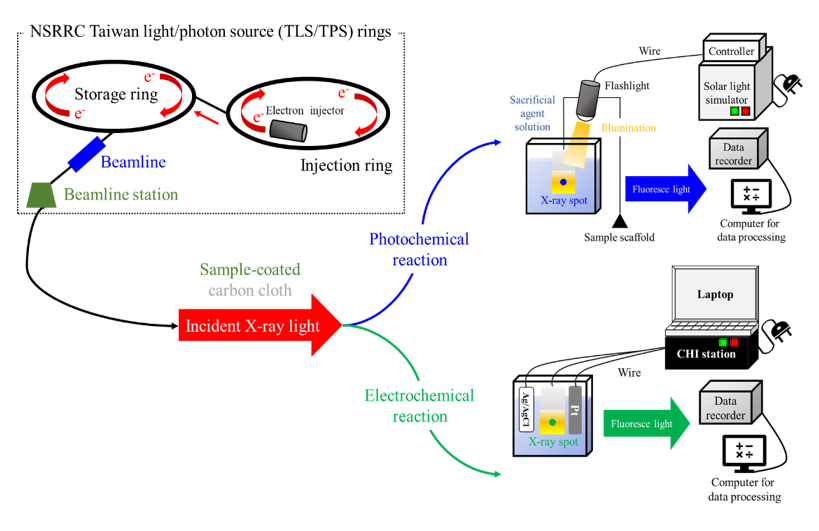Video Article Open Access
Development of Green Energy Materials: Role of Synchrotron X-ray Spectroscopy
Chao-Lung Chiang*, Yan-Gu Lin
National Synchrotron Radiation Research Center, 30074, Taiwan
Vid. Proc. Adv. Mater., Volume 3, Article ID 2208307 (2022)
DOI: 10.5185/vpoam.2022.08307
Publication Date (Web): 21 Nov 2022
Copyright © IAAM
Graphical Abstract

Abstract
The development of green and clean energy materials has got the significant processing with the aids of promotion from government and raising environmentalism. Global nations have signed with Glasgow Climate Pact in UK (COP26) under the frameworks of UNFCCC in 2021 to declare the termination of coal era and the beginning of green-clean energy, the development of green and clean energy materials becoming an unstoppable trend. In this article, several works done with self-assembled experimental mode and beamline stations in National Synchrotron Radiation Research Center (NSRRC) were introduced to explain the variations of material composition, crystal structure, phase transition, electron configuration, valence, and coordination environment from the modifications or photoelectrochemical reactions measured by synchrotron radiation spectroscopy. Herein, we used an in-situ X-ray diffraction (XRD) beamline to observe the phase transition mechanism of a lithium anode battery material, Bi2Mo3O12 (BMO) during a charge-discharge cycle, which comprised three steps, including (1) BMO+6Li++6e-→3Li2MoO4 (LMO)+2Bi, (2) LMO+xLi++xe-→Li2+xMoO4, and (3) Bi+3Li++3e-→Li3Bi (BL). A photocatalyst, SrTiO3/TiO2 (STO/TiO2), was compared with pristine TiO2 and characterized using soft X-ray absorption spectroscopy (XAS) beamline to reveal the existence of unique electron configuration at outer orbitals in STO/TiO2. From the collected Ti L2,3-edge XAS spectra, the ratio value differences in t2g/eg and (d_z^2)⁄d_(x^2-y^2 ) between STO/TiO2 and TiO2 revealed that the addition of STO leads to the increase of unoccupied state and generation of electrons holes, following a structural asymmetry, stretching, and distortion, thus enhanced the electron-hole separation efficiency, electron transition, and further photocatalytic performances. Moreover, the metal valence and coordination of a supercapacitor material, NbN@C, was also measured with hard XAS spectra. In comparison with niobium standards, Nb and NbN, the niobium valence of NbN is Nb3.59+ which is higher than Nb3+ in NbN standand, revealing the existence of niobium vacancy and surface oxidation. The coordination number of first-shell (Nb-Nb) and second-shell (Nb-N) in NbN@C were 4.95 and 9.90 that are smaller than that of NbN ones (first-shell: 6.00; second-shell: 12.00), demonstrating the existence of intrinsic structural defects. This structural defects provide an external transition channel for lithium ions to improve the performances of supercapacitor. In summary, these synchrotron radiation spectroscopy-based findings in various energy materials development were described to explain the meanings for the composition design of green energy materials and the terminal modular of materials.
Keywords
Synchrotron X-ray spectroscopy; Photoelectrochemical reaction; Green-energy materials; Reaction mechanism.
Acknowledgement
We highly appreciate for the supports from managers in beamline stations in NSRRC and the fund supports.
References
- K. Tian, H. Lu, L. Bu, X. Huang, C. L. Chiang, S. Yang, Y. Zhao, Y. G. Lin, J. Zhao; Batteries & Supercaps, 2021, 3(12), 1260.
- T. T. Wang, C. L. Chiang, S. Narra, J. L. Lin, S. W. Chien, J. C. Yu, E. W. G. Diau, Y. G. Lin, and M. C. Lin; J. Phys. Chem. C, 2021, 125(44), 24340.
- S. Zhou, C. L. Chiang, J. Zhao, G. Cheng, T. B. Bashir, W. Yin, J. Yao, S. Yang, W. Li, J. Wang, X. Wang, Y. G. Lin, and L. Gao; Adv. Funct. Mater., 2022, 2112592.
Biography
Chao-Lung Chiang is now a post-doctoral researcher at National Synchrotron Radiation Research Center and also a reviewer for many SCI journals including Groundwater for Sustainable Development, Journal of Natural Gas Science and Engineering, Fuel, Chemical Engineering Journal, Environmental Pollution, Journal of Hazardous Materials, Diamond and Related Materials, Journal of Cleaner Production since 2018. He received a bachelor’s degree in chemical and material engineering from Chang Gung University in 2011, a master’s and doctoral degree in chemical engineering and materials science from Yuan Ze University in 2013 and 2018. He was a guest researcher in Australian Nuclear Science and Technology Organization (ANSTO) for soft biomedical matter development in 2017. His current research fields are photoelectrochemical materials for hydrogen and oxygen generation from water splitting and synchrotron radiation X-ray absorption spectroscopy for material characterization. He is also interested in the fields of carbon capture, storage, and utilization (CCSU), heterogeneous catalysis, environmental contaminant treatment, and antibacterial material. Since past 10 years, he has published 45 SCI articles and 80 conference abstracts in proceedings, participated 13 research projects with his supervisors, and awarded for The Phi Tau Phi Scholastic Honor Society Honorary Membership and other certificates in conferences owing to his outstanding performances in academia
Video Proceedings of Advanced Materials

Upcoming Congress



